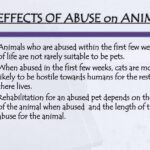Animal cruelty is a profound societal ill, a blight on our shared humanity that manifests in the suffering of innocent beings who cannot voice their pain or seek help. The legal ramifications for such abhorrent actions are manifold and vary significantly depending on the jurisdiction, the severity of the offense, and the circumstances surrounding it. This intricate web of laws reflects society’s escalating awareness of animal welfare issues and the ethical imperatives that inform them.
At its core, animal cruelty encompasses any act that causes unnecessary pain or suffering to an animal. This could range from neglect, where an animal’s basic needs are not met, to overt acts of violence, such as torture or killing. As societal values evolve, governments have incrementally amended and enacted laws that aim to punish offenders and deter future cruelty. Understanding the legal landscape is pivotal in advocating for animal rights and holding perpetrators accountable.
One primary factor differentiating animal cruelty cases is the classification of the offense, which plays a significant role in determining the type of punishment imposed. Broadly speaking, these offenses can be categorized as misdemeanors or felonies. Misdemeanors often involve less severe conduct, while felonies frequently pertain to egregious acts of cruelty that cause considerable suffering or injury. The distinction draws a parallel to the spectrum of human law, where the intensity of the crime dictates the corresponding sentence.
Misdemeanor animal cruelty might occur when a pet is left without food and water for an extended period, leading to dehydration or starvation. Such acts, while serious, may result in lighter penalties, typically involving fines, community service, or a brief stint in jail. Penalties for misdemeanors usually carry the potential for incarceration of up to a year, alongside monetary fines that could range from several hundred to several thousand dollars. In some states, mandatory educational programs about responsible pet ownership might also be imposed, intending to rehabilitate the offender rather than solely punish them.
Conversely, when the cruelty escalates into egregious acts—such as severe physical abuse, fighting animals, or killing—charges often elevate to felony status. Felony animal cruelty cases resonate with a societal outrage that underscores a more robust legal reaction. Such actions often suggest a pervasive disregard for life and can be indicative of broader behavioral issues that might affect human victims as well. For example, studies have long established a correlation between animal abuse and violent crimes against humans, thereby amplifying the imperative for stringent legal intervention.
In terms of punishment, felony convictions carry heftier penalties, potentially including several years of imprisonment. Depending on the jurisdiction, sentences may range from one to ten years or more, especially in instances of repeat offenses or particularly horrific acts. Additionally, fines for felony animal cruelty can soar into the tens of thousands of dollars, imposed on top of other legal consequences, providing a stark warning to would-be offenders.
Moreover, within the legal framework, many states have adopted “aggravating factors” that can enhance an offender’s sentence. Factors such as prior convictions for similar offenses, the brutality of the act, and the vulnerability of the victim (young animals, for instance) may all play a crucial role in determining the severity of the punishment. Courts increasingly recognize that cruelty towards animals reflects a moral failing that warrants not just reprimanding but an acute societal response.
In addition to the legal repercussions, societal backlash often accompanies animal cruelty cases. Public sentiment can shape the legal landscape profoundly, as media coverage ignites conversations around justice for animals. Social media amplifies these dialogues, mobilizing citizens to take action against cruelty and advocate for change. Activism in this realm has surged, with organizations campaigning for stronger laws and humane treatment of animals, often bringing attention to individual cases that catalyze legislative reform.
It is also essential to consider the legal ramifications that persist long after the initial punishment has been served. A criminal conviction for animal cruelty often brings about a disqualification from pet ownership. State laws vary, but it is not uncommon for individuals with a felony conviction related to animal cruelty to be barred from adopting animals. This societal mechanism serves as a preventative measure, declaiming that those who have demonstrated a propensity for cruelty cannot be trusted with the care of another living being.
As we dissect the complexities surrounding the punishments for animal cruelty, it becomes apparent that the stakes stretch far beyond mere legal consequences. They encompass societal values, ethical considerations, and the collective responsibility of humanity to protect those who cannot advocate for themselves. The legal system, while imperfect, reflects an evolving recognition of the value of animal life and the importance of preventing suffering. Emerging from the shadows, laws against animal cruelty stand as beacons of hope, illuminating the path toward a future where kindness triumphs over callousness.
Ultimately, the fight against animal cruelty requires not only stringent laws and penalties but also a cultural shift towards empathy and compassion. Every community must grapple with the question of what it means to coexist with other sentient beings and how we can cultivate an environment that nurtures respect and kindness. It is within this delicate balance that we may finally extinguish the flames of cruelty and embrace a more harmonious existence for all living beings.








